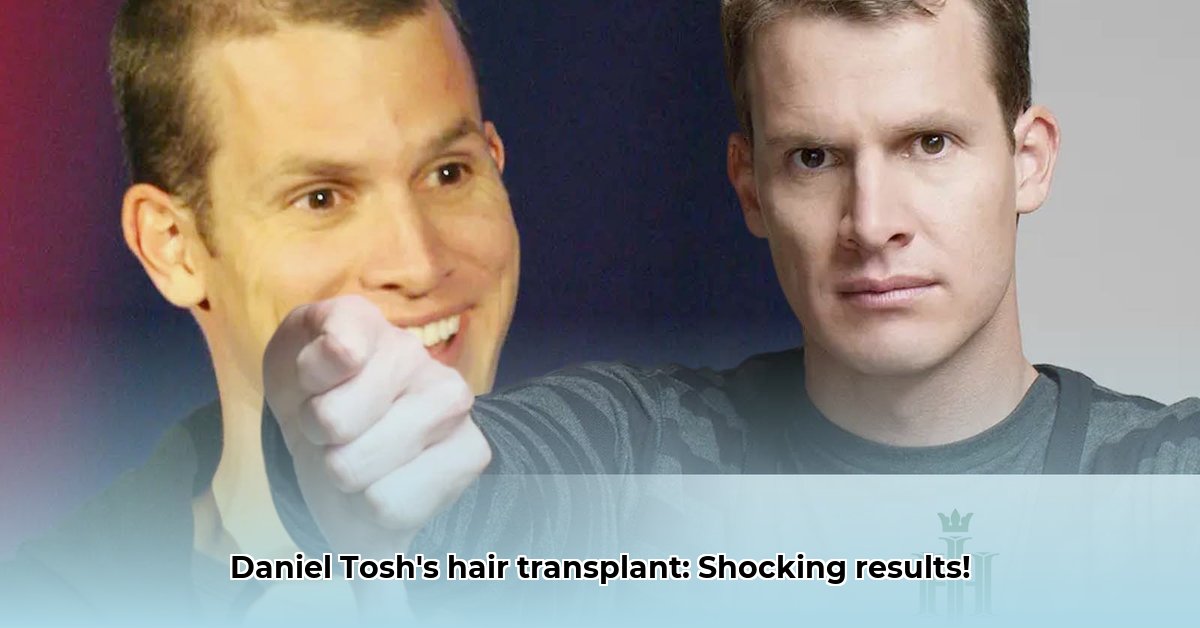
Understanding Hair Transplants: A Step-by-Step Guide
Let's explore the world of hair transplants, inspired by Daniel Tosh's transformation. While the specifics of his procedure remain private, his journey provides a compelling case study for understanding the process. This guide aims to empower you with knowledge, not to speculate on his personal details.
Decoding the Hair Transplant Process: FUT vs. FUE
Hair transplantation is a surgical procedure moving hair follicles from a donor area (typically the back or sides of the scalp) to thinning or balding areas. Two primary methods exist: Follicular Unit Transplantation (FUT) and Follicular Unit Extraction (FUE).
FUT involves removing a strip of skin from the donor area, separating individual follicular units, and meticulously implanting them into the recipient area. Think of it like crafting a finely detailed rug, one strand at a time.
FUE is less invasive. Individual follicles are extracted directly from the donor area using tiny punches. This resembles carefully picking individual flowers, rather than cutting an entire patch. The best approach depends on factors like hair loss extent, scalp characteristics, and surgeon expertise. A skilled surgeon will guide you toward the most suitable technique. What is the crucial element to consider when choosing between FUT and FUE? The surgeon's expertise is paramount in determining the best procedure for your individual needs.
Choosing the Right Surgeon: A Critical Decision
Selecting the right surgeon is crucial. Consider this a significant investment in your appearance and confidence. Thorough research is essential. Examine their credentials, years of experience, and—most importantly—review their actual results. Don't rely solely on polished before-and-after photos on their website; seek out less-edited images for a realistic perspective. Inquire about their experience with both FUT and FUE, and ask directly about their failure rate—a transparent surgeon will readily provide this information. A good surgeon will answer your questions fully.
Pre- and Post-Operative Care: Maximizing Your Results
Pre-operative preparation involves following your surgeon's instructions. This may include dietary adjustments, medication to minimize bleeding or enhance healing, and modifications to your hair care routine.
Post-operative care is equally vital. Adherence to your surgeon's instructions is paramount for optimal and natural-looking results. This may include using specific shampoos, medications, and even adjusting your sleep habits. Consistent care is vital for successful recovery. Neglecting post-op care can negatively impact the outcome and potentially lead to complications.
Realistic Expectations: Beyond Celebrity Transformations
Celebrities' transformations are often impressive but remember that individual results vary significantly. Highly polished post-operative photos often don't reflect the complete recovery journey. Maintain open and honest communication with your surgeon to set realistic goals. The goal is not only hair restoration, but also a boost in self-confidence.
The Long Game: Long-Term Maintenance
Hair transplantation is not a one-time solution. It requires ongoing maintenance, including following your surgeon's hair care recommendations, maintaining a healthy lifestyle, and possibly utilizing medications to support hair growth as advised by your doctor. Think of it like maintaining a luxury car; regular maintenance is key to preserving its appearance.
The Cost of a Hair Transplant: Factors Influencing Price
The price of a hair transplant varies significantly. Factors include the number of grafts needed (more grafts mean a higher cost), the surgeon's experience and reputation (more experienced surgeons typically charge more), the clinic's location (prices vary geographically), and any additional treatments (like Platelet-Rich Plasma (PRP) therapy, which can enhance results). While Daniel Tosh's specific cost is unknown, this information highlights the importance of getting a detailed cost breakdown from your surgeon before proceeding.
Key Considerations
- Thorough Research: Invest time in researching different surgeons and comparing their approaches and success rates.
- Personalized Consultation: A personalized consultation is crucial to discuss your individual needs and expectations.
- Open Communication: Maintain an open dialogue with your surgeon throughout the process.
- Realistic Expectations: Understand that every individual’s result will vary.
- Post-Op Care: Meticulous attention to post-operative care is crucial for optimal results.
Understanding the hair transplant process is key to making an informed decision. While Daniel Tosh's experience offers inspiration, remember that your journey will be unique. Consulting a qualified hair restoration specialist is essential for achieving the best possible outcome.